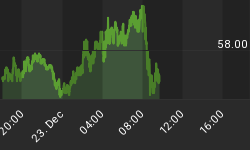"The extension of the bull market in precious metals may very well still be preparing to get underway... The daily chart shows gold approaching oversold levels on the RSI and first support at the 200-day moving average... An upward move faces overhead resistance at the 5-week moving average, about $664, and the 5-day average at $672. Silver... has a relative equilibrium point around which the white metal may remain bound until the fundamental undercurrents suggesting a new surge in metals are realized." ~ Precious Points: Precious Mettle, July 28, 2007
Last week saw some temporary relief for the major stock indices, but precious metals were able to make and sustain important advances that had them soundly outperforming stocks on the whole. After gold climbed back above, and successfully retested, its 5-week moving average, I alerted members at the TTC forum that the way had been cleared for as high as $680 this week. After a temporary pause at $672, gold climbed to the high of the week Friday right under this important level, about $679.40. As the chart below reveals, this level is the bottom of a crucial make-or-break area that will either be strong resistance for the next period of consolidation or strong support for the next major leg of the bull market. MACD is ready for either a positive crossover or another top, but RSI suggests gold could still have room to run.

Silver, as shown in the chart below, moved back up into the area where the 5-, 50-, and 200-day moving averages converged last month, the approximate short term equilibrium point described last week.

So far, the credit crunch panic has worked to the benefit of the metals and those who own them, but blindly relying on this to continue without any sort of correction is a risky bet. Another succesful retest of the 5-week moving average, currently below $670, would further solidify the strength of the current uptrend, as would a retest of the 50-week average, though to a much lesser extent in the short term. The simple fact that should be a concern is that investors don't usually accumulate gold when cash becomes relatively scarce, they tend to do the opposite and move toward liquidity. The near term fate for metals, then, may rest entirely on whether the current situation is a minor, though possibly overstated, repricing of risk, or whether there are serious economic consequences about to be inflicted on the U.S. economy as a whole.
Which of course brings the attention of just about the entire civilized world to Ben Bernanke and the FOMC meeting next Tuesday. The outlook in last week's update, and most of all the recent editions, have been predicated on the notion that eventually the Fed will be driven to accommodate the market either through a rate cut or through excess liquidity injections. Though the total sloshing funds decreased this week, remember that even the overnight repo loans that disappear from the sloshing data can be lent by broker-dealers nine times over or leveraged in other ways. So, the Fed has continued pushing new money into the system, but this new money will go entirely unnoticed compared to the attention that'll be given to the FOMC statement next week. And here, unless there is a marked reversal from recent posturing, the market could be facing disappointment that could trigger marked selling.
Sure, the unemployment rate went up, inflation has been trending lower, and lenders are threatening the future of the economy by tightening their standards. But does this mean the Fed will necessarily capitulate to the 100% expectation of a cut by year end priced into the Fed funds futures? Discipline has been a consistent theme for both Bernanke and Paulson, who've both essentially overlooked the role of their own institutions and stated the market is to blame for its own excesses and a repricing of risk is both appropriate and necessary. It would be extremely out of character for them to now ride to the rescue of irresponsible lenders and destroy any hope that the market will learn a little discipline. Voting FOMC member William Poole explicitly said this week the Fed woud not act unless "financial- market developments threaten market processes themselves."
It's pretty unlikely this sort of tough love is what the markets are hoping for even if there is little expectation for a rate cut as soon as next week, an empassioned plea from Jim Cramer notwithstanding. More likely than not, the Fed will attempt to placate what is approaching outright panic in some circles and will feel compelled to amend the language of its statement, but in what regard, and how this will effect their overall economic outlook is anybody's guess. As is the market's response.
What can be reasonably expected though, is that the Fed, watching global interest rates and the price of gold rise, will resist an outright rate cut for as long as possible, though it will very likely continue quietly expanding bank reserves to mitigate damage to the system and spur liquidity. If conditions deteriorate and the Fed does eventually change its course and cut rates, this will virtually guarantee, though possibly delay, the inevitability of a serious new bull run in dollar denominated precious metals.















